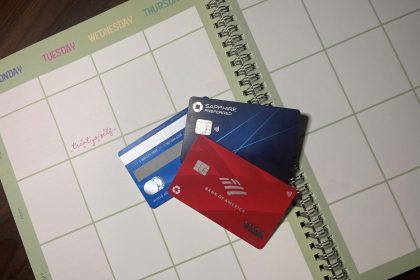Key takeaways
- Joint checking accounts let two people manage shared expenses with equal access to funds — ideal for couples, parents with teens, or adult children helping aging parents.
- The best joint checking accounts offer no monthly fees, competitive APYs and features like overdraft protection and mobile banking tools.
- Before opening an account, compare rates, overdraft policies and digital tools that fit both owners’ needs.
Joint checking accounts simplify shared finances, whether you’re splitting rent with a partner, helping an aging parent pay bills or teaching your teenager money management. The right account eliminates the hassle of splitting payments, Venmo-ing each other or tracking who paid what.
Here are Bankrate’s top-rated joint checking accounts for November 2025, with updated APYs and new offers from online banks and credit unions.
Want to compare other accounts? See Bankrate’s picks for best checking accounts.
Best joint checking accounts
Note: Bankrate’s editorial team validates this information regularly. APYs may have changed since they were last updated and may vary by region for some products. Bankrate includes only FDIC banks or NCUA credit unions in its listings.
| Bank | APY | Monthly fee | Minimum deposit | Best for |
|---|---|---|---|---|
| Ally Bank Spending Account | 0.10% APY on balances under $15,000 | 0.25% on balances $15,000+ | $0 | $0 | Couples managing everyday spending |
| Discover® Cashback Debit | 1% cash back on up to $3,000/mo | $0 | $0 | Debit card users who want cash back on everyday spending |
| SoFi Checking & Savings | Up to 0.50% APY on checking | Up to 4.30% APY on savings (requires direct deposit) | $0 | $0 | Couples building savings alongside everyday spending |
| Capital One 360 Checking | 0.10% APY on all balances | $0 | $0 | Joint owners who want online banking with occasional branch access |
| EverBank Yield Pledge Checking | 0.25% APY on all balances | $0 (with $5,000+ balance or $5,000+ in monthly direct deposits) | $100 | Joint owners who want consistently competitive rates without chasing promotions |
| Alliant High-Interest Checking | 0.25% APY on all balances | $0 | $25 | Couples who want high-yield checking with credit union benefits |
| NBKC Everything Account | 1.75% APY on all balances | $0 | $0 | Couples who want high-yield checking and integrated savings |
| Chase Total Checking® | No APY | $12 (waived with $500+ in monthly direct deposits, or $1,500+ daily balance, or linked to Chase Premier Plus Checking or Chase Premier Platinum Checking) | $0 | Joint owners who prioritize branch and ATM access |
-
Ally combines everything you’d want from an online bank — above-average interest rates, zero fees, and genuinely useful tech features. The tiered APY structure rewards you for keeping a higher balance, making this ideal if you’re pooling funds for upcoming expenses or maintaining a buffer.
The standout feature: Ally’s round-up tool. Connect your Ally Spending Account to an Ally Savings Account (which earns 3.30% APY), and every debit card purchase automatically rounds up to the nearest dollar. Those pennies go straight into savings. If both account holders are swiping the debit card regularly, you’re building savings without thinking about it.
-
Capital One threads the needle between online and traditional banking. You get the perks of an online bank (competitive rates, no fees, strong mobile app) with the option to visit Capital One branches on the East Coast and South, or Capital One Cafés in select Western states.
The real advantage: cash deposits. Unlike most online banks, Capital One lets you deposit cash at branches and cafés at no charge. If either account holder deals with cash regularly — think side gig payments, tips or gifts — this solves a major pain point.
-
Chase can’t compete on interest rates, but it wins on access. With over 4,700 branches and 15,000 ATMs nationwide, Chase offers the largest banking network in the country.
If you or your co-owner value in-person service or need frequent ATM access while traveling, that’s worth something.Plus, Chase regularly offers new account bonuses ($200-$300 is typical) when you set up direct deposit. For couples opening their first joint account together, that’s free money just for switching banks.
-
If you and your joint account holder primarily use debit cards, Discover turns everyday spending into rewards. Earn 1% cash back on up to $3,000 in monthly debit purchases — that’s $30 back per month, or $360 per year. For a couple splitting groceries, gas, and dining out, this adds up fast.
Discover also includes fee-free overdraft protection (when you link a savings account) and lets you deposit cash for free at Walmart locations nationwide.
-
NBKC’s “Everything Account” combines checking and savings in one product paying 1.75% APY on all balances — significantly higher than most checking accounts. The built-in savings goal-setting tool helps couples track progress toward shared goals (vacation fund, down payment, emergency buffer) without opening multiple accounts.
You also get early direct deposit (up to two days early), no minimum balance requirements, and a large fee-free ATM network.
-
SoFi automatically opens both checking and savings when you sign up, which makes it easy for couples to separate “money to spend” from “money to save.” The checking account pays up to 0.50% APY (competitive for checking), while the savings account earns up to 4.30% APY when you set up direct deposit.
SoFi’s round-up feature mirrors Ally’s: every debit card purchase rounds up to the nearest dollar, with the difference transferred to savings. This passive saving strategy works especially well when two people are using the same account for daily expenses.
You also get early direct deposit, a large fee-free ATM network, no overdraft fees, and no account minimums.
Why open a joint checking account?
Joint checking accounts streamline shared financial responsibilities. Instead of splitting every bill, Venmo-ing your partner constantly, or maintaining complicated spreadsheets, joint accounts put shared money in one place where both owners have equal access.
“Joint checking accounts allow for joint fiscal management between individuals,” says Michelle Smoley, director of personal and college finance at Bright Horizons College Coach. “This can be beneficial for spouses, parents with young adult children, and adults with aging parents.”
The practical benefit: immediate access. If one account owner becomes unable to manage finances (due to illness, injury, or death), the other owner can still access funds and handle financial obligations without legal complications.
Risks of having a joint bank account
Joint accounts come with shared risk. Both owners have full legal access to all funds — which means either person can withdraw the entire balance at any time without the other’s permission.
If a relationship ends badly (divorce, family dispute, financial disagreement), one owner could empty the account before the other realizes what’s happening. If this occurs, your recourse is limited. You could sue in small claims court, but there’s no guarantee you’ll recover your money.
Only open joint accounts with people you trust completely. For relationships that aren’t committed long-term, consider alternatives like splitting bills manually, using payment apps or maintaining separate accounts with a shared expense tracking system.
What to look for in a joint checking account
No monthly fees
Many checking accounts charge $10-$15 monthly maintenance fees unless you meet specific requirements (minimum balance, direct deposit, or minimum monthly transactions). Over a year, that’s $120-$180 lost to fees.
The best joint checking accounts eliminate this entirely. Online banks typically offer fee-free accounts with no strings attached, while traditional banks often require you to jump through hoops to avoid fees.
Competitive APYs
Most checking accounts pay little to no interest. But if you’re keeping a cushion in checking for shared expenses, rent, or emergency funds, that money should be earning something.
Look for checking accounts paying at least 0.10% APY. The best high-yield checking accounts pay up to 1.75% APY — not as high as dedicated savings accounts (4.00%+ APY), but significantly better than the 0.01% most traditional banks offer.
Compare the best high-yield checking accounts.
Fee-free overdraft protection
With two people spending from one account, overdrafts become more likely. The best joint checking accounts offer fee-free overdraft protection by linking to a savings account or allowing small negative balances without penalty.
Some banks let you overdraw by up to $50 without fees. Others charge $30-$35 per overdraft — which adds up fast if you’re not tracking spending carefully between two users.
Mobile banking and budgeting tools
A strong mobile app is non-negotiable for joint accounts. Both owners need to:
- Check balances in real-time
- Set up spending alerts
- Transfer money between accounts
- Deposit checks remotely
- Lock or freeze debit cards if lost
Some accounts include budgeting tools, spending categorization, and savings goal trackers — useful features when two people are managing shared finances.
Round-up features and automatic savings
If you’re opening a joint checking account with a partner, consider accounts that include round-up savings features. Every debit card purchase rounds up to the nearest dollar, with the difference automatically transferred to savings.
When both account holders are using the same debit card regularly, these small amounts add up to hundreds of dollars in savings annually — without requiring any active effort.
Sign-up bonuses and perks
Many banks offer $200-$300 sign-up bonuses when you open a new checking account and set up direct deposit. If you’re opening a joint account for the first time, this is essentially free money for switching banks.
Some checking accounts also offer debit card rewards (like Discover’s 1% cash back) or access to high-yield savings rates when you bundle accounts.
Find the best checking account bonuses available now
Safety and insurance
Only open accounts at FDIC-insured banks or NCUA-insured credit unions. This protects your deposits up to $250,000 per depositor, per institution, per account category in the event of bank failure.
For joint accounts, FDIC insurance covers $250,000 per co-owner — meaning a joint account with two owners is insured up to $500,000.
How to open a joint checking account
Opening a joint checking account works just like opening an individual account, except both owners need to provide personal information:
- Full legal name
- Date of birth
- Social Security number
- Email address
- Phone number
- Physical address
- Government-issued ID (driver’s license, passport, or state ID)
Opening deposit: Some banks require minimum opening deposits ($25-$100 is typical), though many online banks have eliminated this requirement entirely.
Here’s a step-by-step process to opening a joint account:
- Choose your account from our recommendations above
- Start the application online (most banks allow full online applications)
- Enter both account holders’ information — both people need to be present or available to provide details
- Fund the account via bank transfer, debit card, or check deposit
- Activate debit cards when they arrive (typically 7-10 business days)
Can you add someone to an existing checking account? Some banks allow you to convert individual accounts to joint accounts by adding a second owner. However, this varies by institution — many require you to open a new joint account and transfer funds from the individual account.
Joint checking account FAQs
Research methodology
Bankrate researches and reviews over 100 banks, including some of the largest financial institutions, online-only banks, regional banks and credit unions with both open and restrictive membership policies.
To find the best joint checking accounts, we looked at which of our highest-rated checking accounts allow joint checking as these accounts are equally great options for sharing with someone as they are for an individual. Most of the highly-rated checking accounts were from online-only banks, so we also included Chase as an option for those with a joint owner who may not be comfortable banking online and wants access to a brick-and-mortar bank. We chose Chase as it has branches in 48 states and Washington, D.C.
To find the best joint checking accounts for kids and teens, we looked at which of our broadly-available banks and credit unions offered an account specifically for kids or teens. Then, we looked at the features each one provided, such as APY and parental controls and spending limits, to determine which accounts were best for kids and teens to use and learn money management skills.
Learn more about how we choose the best banking products and our methodology for reviewing banks.
Why we ask for feedback
Your feedback helps us improve our content and services. It takes less than a minute to
complete.
Your responses are anonymous and will only be used for improving our website.
Help us improve our content
Read the full article here
















